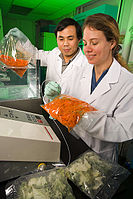
Photo from wikipedia
Abstract Liquid Air Energy Storage (LAES) stores electricity in the form of a liquid cryogen while making hot and cold streams available during charging and discharging processes. The combination of… Click to show full abstract
Abstract Liquid Air Energy Storage (LAES) stores electricity in the form of a liquid cryogen while making hot and cold streams available during charging and discharging processes. The combination of electricity, hot and cold makes LAES a promising asset for the management of multi-energy streams in various energy systems; however, such opportunity has not received attention so far. To overcome the traditional view of LAES as electricity storage only, this study investigates the techno-economic value of using LAES as a smart multi-energy asset for the provision of heat and cold, alongside power, in districts with heating and cooling networks. A reduced thermodynamic model of LAES was developed, validated and used to i) quantify the thermodynamic efficiency for a multi-energy LAES, ii) generalise the multi-energy capability of LAES over the three energy vectors considered iii) link different plant designs and integration conditions – in terms of loads and temperatures – with the associated multi-energy LAES performance and iv) describe multi-energy LAES operation as part of two district sizes, for provision of peak and base load. It is found that, by leveraging the vector-coupling capability of LAES, more flexible district operation can be achieved, with increased LAES energy efficiency from 47% to 72.8% and up to 8–12% reduction of operational costs, in the considered integration case studies. Results demonstrate the technical feasibility of multi-energy LAES operation and illustrate the associated trade-offs and potential: new perspectives for smart management of multi-energy systems are opened up.
Journal Title: Energy Conversion and Management
Year Published: 2021
Link to full text (if available)
Share on Social Media: Sign Up to like & get
recommendations!